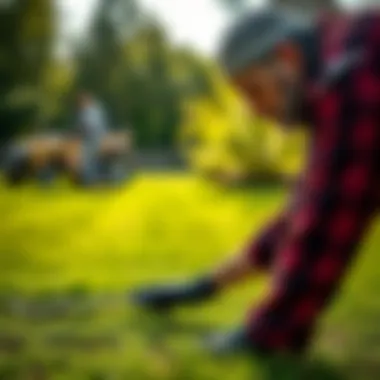Techniques to Even Out Your Lawn Effectively


Intro
An uneven lawn can be a source of frustration for many property owners. Not only does it mar the aesthetic appeal of gardens and outdoor spaces, but it can also pose issues for activities such as mowing, watering, and even playing. Understanding the methods and techniques available to smooth out an uneven lawn is crucial, whether you're a seasoned landscape professional or just dipping your toes in the world of lawn care. This guide aims to shed light on practical approaches to tackle lawn imperfections, ensuring you can transform your patch of grass into the smooth, lush turf you envision.
Key Concepts and Terminology
Definition of Terms
When discussing lawn smoothing techniques, it’s essential to familiarize yourself with some basic terminology. Here are a few key concepts:
- Soil Compaction: This occurs when soil particles are pressed together, resulting in reduced pore space that can affect water retention and aeration. Too much compaction can lead to uneven surfaces.
- Topdressing: This is the practice of applying a layer of soil or compost to the surface of the lawn. It's often used to improve soil quality and correct unevenness.
- Grading: In landscaping, grading refers to the act of leveling the ground to create a uniform surface.
- Dethatching: This process removes the layer of thatch, a build-up of dead grass and roots that can inhibit growth and contribute to lawn unevenness.
Overview of Relevant Practices
There are several practices that lawn enthusiasts can employ to smooth out their yards. Here’s a brief overview:
- Aeration: A technique that enhances the growth of grass by alleviating compaction and allowing for better water and nutrient absorption.
- Sod Repair: Involves either patching or replacing areas of sod that have sunk or been damaged.
- Reseeding: This practice involves planting grass seed in sparse or uneven areas to achieve a uniform look.
Current Trends and Innovations
Latest Research and Developments
Research continues to explore the best practices for lawn maintenance, focusing on eco-friendly approaches. Studies have shown that using biochar can improve soil structure and health, thus contributing to the reduction of uneven surfaces by enhancing drainage and moisture retention.
Emerging Technologies and Tools
New tools are hitting the market to aid in lawn preparation and maintenance. For instance, laser grading technology is emerging as a way to ensure precision in leveling land for landscaping purposes. Automated soil testers are also becoming popular, helping homeowners monitor soil health effectively.
Practical Applications
Step-by-Step Guides
To help you better understand how to apply these concepts, here is a simple guide to smoothing out an uneven lawn:
- Assess Your Lawn: Walk around and take note of the areas that require attention. Look for depressions or bumps.
- Test the Soil: Check for compaction with a garden fork. If it’s hard to push into the soil, it may need aeration.
- Aerate the Lawn: Use a core aerator to pull plugs of soil out, alleviating compaction.
- Topdress with Soil: Apply a layer of compost or soil evenly across the affected areas. Be sure to fill in any dips but avoid covering the grass too deeply.
- Reseed if Necessary: If there are patches where grass is struggling, sprinkle some seed and water it regularly until established.
Troubleshooting Common Issues
If you encounter problems, here are some common issues and quick fixes:
- Persistent Unevenness: Might suggest continued soil compaction. More frequent aeration may be needed.
- Grass Not Growing: Ensure the topdressing isn't suffocating existing grass and that seed is properly watered.
- Weed Problems: They can crop up in disturbed soils. Keep an eye out and employ preventive measures.
"Maintaining a healthy lawn is like tending a friendship; it requires regular attention and care to flourish."
In summary, addressing lawn unevenness is a manageable task with the right methods and knowledge. Whether you choose to aerate, topdress, or reseed, investing time into your lawn's upkeep is well worth the effort. With a little patience and some elbow grease, you'll be well on your way to a smooth, vibrant lawn.
For additional information and resources, refer to University of California Agriculture and Natural Resources or explore community discussions on Reddit.
Understanding Lawn Unevenness
Lawn unevenness is not just a cosmetic issue; it reflects deeper problems in the soil, drainage, and overall lawn care practices. Understanding this concept is essential for anyone interested in achieving a beautifully smooth lawn. When a lawn is uneven, it can affect everything from walking and playing to mowing and watering. Unevenness can lead to water pooling, poor grass growth, or increased pest issues. Before jumping into remedies, it's important to grasp why the lawn appears this way, and what factors contribute to its irregularities.
Common Causes of an Uneven Lawn
Uneven lawns can stem from various sources. A few common culprits include:
- Soil Settling: Over time, areas of soil can compact and settle differently, creating dips and mounds.
- Tree Roots: The growth of tree roots can also push up the soil, leading to uneven patches.
- Animal Activity: Small critters like gophers or moles can create tunneling systems that cause sinking in the surface.
- Improper Grading: Poor initial grading or landscaping can lead to areas that stand out due to height differences.
Familiarizing oneself with these factors allows homeowners and enthusiasts to pinpoint the source of the problem more effectively.
Impact of Soil Compaction
Soil compaction is a sneaky enemy of a smooth lawn. When soil is compacted, its particles are pressed tightly together, which restricts air, water, and nutrient flow. This can create hard spots in the lawn where grass struggles to grow. Compaction often arises from heavy foot traffic or the use of heavy equipment. Even seasonal changes can play a part. In spring or fall when the ground is moist, it's susceptible to being compressed. By addressing soil compaction, you can restore airflow and create a healthier environment for lawn growth.


Role of Water Drainage
Water drainage plays a critical role in maintaining a level lawn. Poor drainage leads to water accumulation in low-lying areas, which can gunk up the soil and create a breeding ground for pests or disease. Conversely, areas that drain too well may dry out, resulting in patchy grass. Keeping an eye on how water behaves in your lawn can provide key insights. For example, look for signs like pooling or erosion after heavy rain, which indicate that your soil or grading may need attention.
A thorough understanding of these foundations sets the stage for tackling lawn issues head-on, preparing the ground for a smooth, healthy surface.
Initial Assessment of Lawn Conditions
Assessing the state of your lawn is the cornerstone of any effective lawn care strategy. It goes beyond just looking at the surface; it's about understanding the health of the soil, the way water interacts with it, and how the grass grows in its environment. A thorough and careful assessment can save countless hours of labor and resources down the line.
When you embark on the journey of smoothing out an uneven lawn, you must anchor your approach with a clear understanding of its current condition. Taking the time to evaluate various aspects can reveal underlying issues that may not be immediately visible. Most often, what appears to be a minor bump can be rooted in significant soil compaction or improper water drainage.
Visual Inspection Techniques
In the realm of lawn care, the naked eye can be quite a powerful tool. Begin with a simple walk-through of your lawn. Look closely for uneven patches, areas with discolored grass, or poor drainage spots, especially after heavy rain. Pay attention to the feel of the ground—firm, pressed spots could signify compacted soil while spongy areas might indicate excessive moisture retention.
- Use Your Senses: Smell the soil. A rich, earthy aroma can indicate healthy microbes at work, while a musty scent might hint at rotting organic matter.
- Grass Texture: Different textures indicate different health levels; observe whether the grass is lush and vibrant or thin and struggling.
Using a measuring stick or string can help visualize the slopes and dips that may be hard to detect at first glance. Consider taking photographs from various angles as you survey your yard. This will help track changes and guide your work.
"An informed lawn care strategy begins with a careful layout of what you have before you can hope to fix it."
Measuring Levels and Slopes
To get a precise grip on the overall condition of your lawn, it's essential to measure levels and slopes accurately. This can determine how water flows across your yard, highlighting potential areas that may breed problems like puddles or dry patches.
- Tool Selection: Invest in a simple level or a transit level if your lawn’s unevenness is pronounced. These tools will allow you to measure elevation changes accurately.
- Marking Areas: Create a grid across your lawn using stakes and string. Measure the height at intersections to get a clear picture of elevation changes.
- Identify Flat Areas: Note where the ground remains level, then track the transitions to slopes and dips.
- Record Heights: Document each elevation you measure; this will provide important data for planning your corrective measures.
In this process, you may also consider creating a little map of your findings, sketching out the fluctuations and noting areas of particular concern. This kind of groundwork will prove invaluable as you progress toward a smooth and healthy lawn.
Essential Tools and Equipment
When it comes to smoothing out an uneven lawn, the right tools and equipment play a pivotal role. Having appropriate gear not only makes the job easier but also enhances the quality of the results achieved. Whether you're just starting to address lawn unevenness or looking to maintain a pristine outdoor space, understanding the essential implements is crucial. These tools can help you accurately assess the condition of the lawn, take necessary corrective actions, and promote the overall health of the grass.
Recommendations for Leveling Tools
Opting for the correct leveling tools is fundamental to your lawn smoothing endeavors. Each tool serves a specific purpose and, when used correctly, can lead to a beautifully managed area. Some of the most recommended tools include:
- Lawn Roller: This heavy-duty tool helps compress soil, aiding in the elimination of slight bumps and dips. It can be filled with water or sand to adjust weight for efficiency.
- Lawn Rake: An essential for gathering loose grass and debris, it can also assist in spreading soil for topdressing. A thatch rake is excellent for breaking up dense turf as well.
- Leveling Bar: Often made of metal, this bar is great for scraping across the ground to level out imperfections. It fits into tight spots where larger tools can't reach.
- Shovel and Spade: Used to move soil or adjust topography, shovels are invaluable for major changes in landscape.
In addition to these tools, having safety gear such as gloves and proper footwear ensures personal safety while working on the lawn.
Importance of Soil Testing Kits
Soil testing kits may not be the first thought when tackling a bumpy lawn, but their importance cannot be overstated. Knowing your soil's composition is key to understanding why unevenness may occur. Here’s how soil testing can greatly influence your lawn care strategy:
- Nutrient Identification: It reveals nutrient levels, helping you decide if further amendments are necessary. If your soil is lacking in certain elements like nitrogen or potassium, you can apply specific fertilizers to promote growth and stability.
- pH Level Analysis: The pH level affects how well grass can absorb nutrients. Knowing this can guide the adjustments you'll need to make for optimal grass health. If your soil is too acidic or alkaline, it could lead to uneven growth.
- Microbial Health Assessment: Understanding the microbial activity in your soil can help identify if your lawn is suffering from compaction or poor aeration.
"Healthy soil is the foundation of a vibrant lawn. Testing it provides necessary insights that just observations cannot."
Utilizing soil testing kits not only paves the way for a smoother lawn but also contributes to the sustainability of your garden. Regular testing every couple of years can prevent issues before they arise, saving time, effort, and resources in the long run. By investing in the right tools and taking soil health seriously, you lay the groundwork for a lush, even lawn.
Techniques for Smoothing Out the Lawn
Smoothing out an uneven lawn is more than just for appearance; it’s about forging a strong base for grass and other plants to thrive. Techniques used for this endeavor can vary greatly, but each carries its own importance and benefits. When lawns are uneven, not only does it affect aesthetics but also contributes to poor drainage and potential damage to equipment.
Proper smoothing can significantly enhance the lawn's usability, making it ideal for activities such as picnics or sports. This section delves into various methods and techniques that will transform that bumpy terrain into a smooth, inviting oasis.
Topdressing with Soil Mixtures
Topdressing is one of the most effective techniques for leveling a lawn and involves spreading a layer of soil mixture over the lawn's surface. This method aids in filling low spots and promoting healthier grass growth. Topdressing is an economical and less labor-intensive technique that can be utilized to enhance the lawn’s overall quality.
Types of Soil Mixtures


Different types of soil mixtures can be used in topdressing, each tailored for specific grass types and soil conditions. A common mix consists of a blend of topsoil, compost, and sand.
Key characteristics:
- Topsoil: A top layer rich with nutrients, fostering robust growth.
- Compost: Introduces organic matter, which enriches the soil and supports microbial life.
- Sand: Aids drainage and improves soil structure, especially in clay-heavy areas.
The unique feature of this mixture is its versatility. Not only does it level the uneven surface but it also improves soil health, which is crucial for sustainable lawn management. The downside is that for those with limited knowledge, mixing the components can lead to incorrect consistency, which then may not achieve the desired results.
Application Methods
Applying the topdressing mixture requires a keen approach to ensure even distribution. One popular method is to use a broadcast spreader, which evenly disperses the mixture across the lawn. Key characteristics include:
- Accessibility: Suitable for most homeowners, easy to operate.
- Even Coverage: Ensures that all areas benefit from the topdressing, reducing the risk of patches.
The unique feature of application methods lies in how they can adapt to the lawn's size. While larger spreaders work for extensive areas, smaller handheld versions can be just as effective for modest yards. A consideration for application is timing; poolers of soil mixture in wet conditions can lead to clumping, which undermines the entire process.
Reshaping with Rakes and Rollers
Reshaping the lawn using rakes and rollers is a hands-on method that allows for immediate correction of surface irregularities. This process can be particularly beneficial for newly seeded lawns where uneven settling occurs. By using a landscape rake, you remove high spots while filling in low areas, facilitating easier water flow and healthier grass growth.
Using a Power Leveling Tool
For those seeking efficiency, a power leveling tool takes the grunt work out of leveling an uneven lawn. This tool utilizes mechanical advantage to adjust the surface level quickly and uniformly. Particularly useful for larger properties, they can save time and ensure a consistent finish.
Key Consideration: Though higher in initial cost, investing in quality equipment could circumvent recurring labor costs associated with manual leveling techniques. In addition, understanding machine adjustments and settings can maximize results, ensuring your efforts really pay off.
By adopting these methods, anyone can tackle the challenges posed by an uneven lawn. Each technique offers unique benefits that can lead to a flourishing green space, tailor-suited to your needs.
Addressing Soil Compaction
Soil compaction is a fundamental issue that can hinder the health and appearance of your lawn. Understanding how to address this problem effectively is not only pivotal for achieving a smooth surface, but also for enhancing the overall vitality of the grass. When soil becomes compacted, it reduces air pockets, stifling root growth and water absorption. This can lead to weak plants, poor drainage, and an increased likelihood of weeds overtaking your landscape. By prioritizing soil compaction in your lawn care routine, you're investing in a lush, thriving outdoor space that can withstand the tests of time and climate.
Aeration Techniques
Aeration is the process of creating small holes in the lawn to alleviate soil compaction and improve the grass's access to air, water, and nutrients. There are several methods available, and the choice depends on various factors such as the size of your lawn, the type of soil, and the specific grass variety. Here are a few techniques:
- Core Aeration: This popular method removes small plugs of soil, allowing oxygen to penetrate deeper into the ground. The discarded soil plugs naturally decompose, enriching the topsoil with organic matter.
- Spike Aeration: Using a spiked aerator, you simply poke holes into the soil without removing any material. While this method is easier, it's generally less effective for severe compaction.
- Liquid Aeration: A newer technique involves applying a liquid solution that breaks down soil particles, enhancing air flow and water retention. This option can be particularly useful for gardens where traditional machinery may be cumbersome.
By understanding the conditions of your lawn, you can choose the aeration technique best suited to address compaction and rejuvenate your grass.
Impact of Organic Matter Addition
Adding organic matter to your lawn can dramatically influence its structure and health. When you introduce materials like compost, peat moss, or well-rotted manure, you’re not just enhancing nutrients; you’re also improving the soil's texture and water retention capabilities.
Benefits of incorporating organic matter include:
- Improved Soil Structure: Organic materials help bind soil particles together, preventing them from compacting too densely.
- Enhanced Water Drainage: With better soil structure, water can flow through more easily, reducing standing water and promoting healthier root systems.
- Increased Microbial Activity: A richer soil ecosystem leads to more beneficial microbes, which can further assist in breaking down organic material and providing nutrients to the lawn.
Water Management for Lawn Health
Effective water management is crucial for maintaining a healthy lawn. An even distribution of moisture not only nurtures grass but also plays an essential role in maintaining a smooth surface. An uneven lawn can stem from poor watering practices; spots that get too much water often lead to muddy patches while dryer areas may struggle with underdevelopment. Therefore, understanding and implementing proper water management techniques can significantly alleviate issues related to lawn unevenness.
Optimizing Irrigation Practices
Optimizing irrigation practices is about striking a balance between the water needs of your lawn and the prevailing weather conditions. With this, not only do you promote healthier grass, but you also ensure your lawn remains level.
- Understand your lawn's needs. Different grass types have varying water requirements. For instance, a cool-season grass such as Kentucky bluegrass may need more frequent watering during hot summers compared to warm-season grasses like Bermuda.
- Utilize smart technology. Consider installing smart irrigation systems that adjust automatically based on weather forecasts. These systems save water and prevent overwatering, which can cause soil erosion and uneven growth.
- Timing is everything. Water your lawn early in the morning or late in the evening to minimize evaporation. This ensures that the water penetrates the soil effectively and provides a common ground for moisture distribution.
- Deep watering practices. Instead of frequent shallow watering, focus on soaking your lawn deeply. This encourages deeper root growth, making your grass more resilient to drought and minimizing localized wet areas that lead to unevenness.
Utilizing Drainage Solutions
Effective drainage is another cornerstone of water management. Without proper drainage solutions, pools of water can form, creating a patchy and uneven lawn. Here are some strategies to consider:
- Gradient leveling. Check if your lawn has a proper slope to facilitate water runoff. If not, you may need to reshape the terrain, creating slight slopes towards designated drainage areas.
- Install drainage systems. French drains or catch basins can efficiently channel excess water away from the lawn. They help to alleviate soggy spots that can disrupt the evenness of your yard.
- Incorporate natural landscape features. Utilize existing features like flower beds, shrubs, or garden paths to redirect water flow. By using natural barriers, you can prevent water from pooling in specific areas.
"Well-drained soil encourages deeper root systems, which is crucial for a vibrant lawn."


- Regular maintenance check. Inspect your drainage solutions regularly. Keeping drains clear of debris, leaves, and sediment can greatly enhance their effectiveness. This way, you’re less likely to encounter flooding in areas that contribute to unevenness.
Preventive Measures for Lawn Maintenance
Maintaining a smooth and healthy lawn goes beyond just correcting uneven spots. It’s essential to understand the significance of preventive measures in lawn maintenance. When you’re proactive, you not only thwart potential issues but also promote a thriving environment for your grass. Preventive strategies can reduce the chances of soil erosion, compacted areas, and uneven growth. This ultimately saves you time, effort, and money in the long run.
Regular Lawn Care Routines
Regular lawn care routines lay the foundation for a vibrant lawn. This isn’t just about mowing once a week; it encompasses various activities that contribute to the overall health of your lawn. Here are some practices to take into account:
- Mowing at the right height: Keeping your grass at the right height can lead to healthier turf. Some grasses thrive at a taller height while others prefer a shorter trim.
- Fertilization: Consistent applications of the right fertilizer can replenish nutrients, which is necessary for dense, green growth.
- Weed control: Weeds, if left unchecked, can choke out your grass, leading to uneven patches. Early intervention is key.
- Pest management: Monitor for pests that can wreak havoc on your lawn. Treating infestations promptly can prevent extensive damage.
- Seasonal events: Adjust your care routine based on the seasons. Some tasks are more pressing during certain months, and adapting can enhance your results.
By sticking to a regular routine, you target the root causes of uneven growth before they escalate into significant problems.
Soil Health Monitoring
Soil health is often overlooked, yet it is a linchpin in your grass’s ongoing vitality. Checking your soil's condition regularly can offer insights into its composition and aid in making informed decisions about its treatment. Here are a few considerations:
- pH testing: An imbalanced pH can hinder nutrient absorption. A pH test can help you understand what adjustments are needed.
- Nutrient levels: Get familiar with essential nutrients like nitrogen, phosphorus, and potassium. Knowledge of these can steer you toward targeted fertilization efforts.
- Organic matter presence: Healthy soil contains organic material that supports microbial life. Adding compost can help enhance this aspect.
- Moisture levels: Consistently monitor moisture levels to ensure your lawn is getting neither too much nor too little water, preventing unevenness.
Keeping an eye on soil health not only aids in maintaining the lawn’s appearance but also fosters a resilient ecosystem that can adapt to weather and usage variations.
"A healthy lawn starts from below – check the soil to nurture above!"
In summary, preventive measures in lawn maintenance serve as the bedrock for addressing unevenness and supporting overall lawn health. By establishing regular care routines and monitoring soil health, you mitigate many of the issues that contribute to an uneven lawn.
Case Studies of Lawn Restoration
Understanding how others have successfully tackled the challenge of an uneven lawn can serve as a guiding light for anyone facing similar issues. Case studies not only illustrate practical techniques but also highlight the varied approaches to lawn restoration, showcasing the unique circumstances that led to different solutions. By delving into these narratives, readers can gain insights into effective methods while avoiding common pitfalls. The process of lawn restoration can be complex, shaped by factors such as climate, soil type, and existing vegetation. Thus, real-life examples provide a treasure trove of practical knowledge that can be directly applied to individual cases.
Successful Lawn Transformations
Examining successful transformations helps demystify the process of achieving a smooth lawn. For instance, a homeowner in Ohio faced a series of dips and lumps in their backyard caused by several disturbances over the years. Instead of succumbing to despair, they took a methodical approach by first assessing the specific causes of their lawn’s unevenness—excessive foot traffic and poor drainage were significant contributors.
The first step in their restoration was topdressing with a well-aerated soil mixture. They applied a blend consisting mainly of compost and sand, which improved both soil quality and texture. This method ensured that the grass roots had better access to nutrients and water.
Once they leveled the surface, they used a combination of aeration techniques to alleviate any underlying compaction. As a vital follow-up, regular soil testing revealed the necessity for certain amendments, which led to healthier grass growth. Over six months, the once uneven yard blossomed into a smooth expanse of vibrant green, and the family couldn’t get enough of their newly usable outdoor space.
"Restoration isn’t just about fixing what's broken but understanding why it broke in the first place."
— Lawn Care Enthusiast in Ohio
Lessons Learned from Lawn Care Experts
The experience shared by lawn care professionals provides invaluable lessons that can aid both seasoned enthusiasts and newcomers. One consistent theme from experts is the emphasis on patience. A lawn won’t transform overnight, and understanding the growth cycles for different grasses is critical. An expert in Kentucky noted that some grass types require a full growing season to show measurable results, emphasizing that consistent care practices yield the best long-term results.
Moreover, experts advocate for regular soil health assessments. They stress that understanding soil composition not only allows gardeners to know what to add but also helps identify potential problems before they escalate. Aeration, watering practices, and the use of organic material are often cited as foundational steps in any restoration project.
Another valuable insight is the creation of drainage solutions tailored to specific yard conditions. For example, a landscape contractor in Florida utilized decorative edging combined with strategic turf patterns to channel water away from problem areas effectively. Such innovative approaches not only solve existing issues but can prevent them from surfacing again in the future.
By reflecting on these case studies, lawn restoration enthusiasts can develop a richer understanding of the myriad techniques available, arming themselves with the knowledge to tackle their own uneven lawns with confidence.
Epilogue and Final Thoughts
As we wrap up our detailed exploration into the realm of uneven lawns, reflecting on what we've covered reveals the significant value this knowledge brings to anyone eager to cultivate a smooth and lush outdoor space. An uneven lawn is not just an eyesore; it can affect the health of the grass, the efficiency of irrigation, and even the enjoyment of the space. The methods to restore balance not only enhance the aesthetic appeal of your yard but also contribute to the overall well-being of the landscape and the environment.
Recap of Effective Techniques
So, what strategies have emerged as most effective through this journey?
- Topdressing with Soil Mixtures: This technique of applying a thin layer of quality soil mixture can rejuvenate a lawn by promoting healthy grass growth and improving soil structure. It's like giving the grass a fresh start.
- Aeration Techniques: By creating small holes in compacted soil, you allow air, water, and nutrients to reach roots more effectively, which is crucial for a robust lawn. This process can relieve stress on the grass during dry spells.
- Correcting with Rakes and Rollers: Using simple tools to reshape and level the lawn can make a world of difference. A good roller helps pack the soil down just right, while a rake can smooth out the surface beautifully.
"The ground beneath your feet reflects the care you put into it; a smooth lawn showcases diligent efforts and love for your outdoor space."
These techniques, when applied thoughtfully, can turn a hilly mess into a splendid expanse of green.
Future Considerations for Lawn Enthusiasts
Looking ahead, lawn enthusiasts should keep several considerations in mind as they embark on their lawn leveling adventure.
- Choose the Right Grass Type: Selecting the appropriate grass for your region and soil type will ultimately support growth and health, making maintenance easier.
- Seasonal Adjustments: Different seasons bring unique challenges for lawn care. Remain aware of how to adjust your practices to accommodate varying weather conditions.
- Sustainability: Eco-friendly practices, such as using organic topdressing materials or native plant integration, can enrich your lawn without harming the environment.
- Continual Education: Keeping up with the latest gardening trends and science can empower home gardeners with fresh ideas and techniques for improved lawn care.
By embracing these considerations, lawn enthusiasts can ensure that their quest for the perfect lawn is both successful and sustainable. Ultimately, the heart of lawn maintenance lies in ongoing care and adaptability to the land itself.







